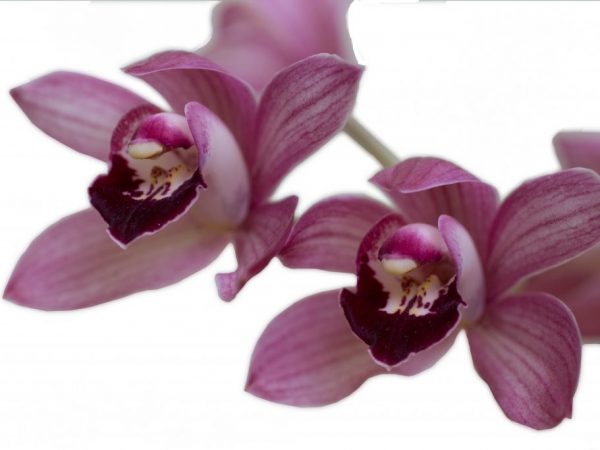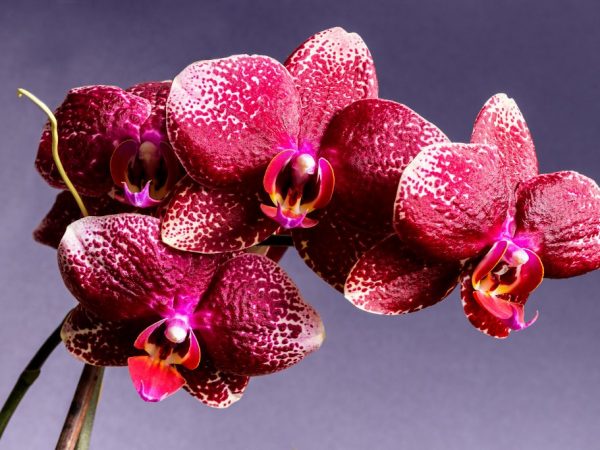Characteristics of the burgundy orchid
Orchid is an exotic decorative flower, the largest family of monocotyledonous plants. There are many different species of this plant, which mainly differ in color and shape of flowers, one of them is the burgundy orchid.

Characteristics of the burgundy orchid
Description of burgundy orchid
Burgundy orchid is a hybrid plant that appeared by artificial crossing of other types of orchids. This flower has another name - burgundy phalaenopsis.
Scientific classification:
- kingdom - plants;
- department - angiosperms;
- class - monocots;
- order - asparagus;
- family - orchid;
- genus - epiphytic.
This is an ornamental plant, in the wild it grows on trees, stumps, even stones and rocks. Most often it is found in tropical forests, belongs to the average species of orchids.
Flower appearance
The orchid has a long thin stem, at the base of which an average of 5 dark green leaves grow. Their size ranges from 30 to 40 cm. They are large, with a smooth glossy surface, and have an oblong oval shape.
Phalaenopsis blooms beautifully, with proper care, the flowering period lasts a whole year. The flowers are dark red or burgundy. The petals are rounded, their average length is 6 cm.The height of the stem is about 50 cm.
Usually flowers are collected in racemose inflorescences, are three-membered, with a double perianth. Sepals are the same, and of 3 petals, the middle one is very different from the rest, forming a lip, which has a long outgrowth back. There are 1-3 stamens.
Plant varieties
The burgundy phalaenopsis orchid has subspecies, which are divided, depending on the shades of the flowers: from rich red to maroon.
Red orchid
The orchid has bright red flowers. The stem is thin, so it is usually tied to sticks that are dug into a flower pot. The leaves of this subspecies are large, dense, dark green. The maximum length is 45 cm.
Flowers are collected in inflorescences, there may be a different number, it depends on the conditions of detention. There are orchids with 40 flowers.
Miniature phalaenopsis
Miniature phalaenopsis got its name because of its small size: the maximum plant height is 20 cm. Unlike small-flowered phalaenopsis, it does not grow to large sizes. This is a rare species that differs from others only from a decorative point of view, its morphological features are the same as those of large species.
Miniature Phalaenopsis is a monopodial plant with a shortened stem. It usually has 2 peduncles that grow from the axils of the leaves. Aerial roots may appear. Its leaves are wide, dense, leathery, their average length is 32 cm. They grow only vertically upwards. The flowers, like those of other phalaenopsis, are similar to butterflies, delicate and bright.
Care features

Orchid - whimsical flower
Phalaenopsis burgundy requires careful maintenance, which consists in proper lighting, proper watering and feeding, as well as choosing a suitable pot.
Lighting
For good growth, burgundy phalaenopsis needs warmth and a lot of sunlight, so a pot with a flower is placed on the windowsills in the sunny side. In the hot summer period, they closely monitor the state of the plant, since direct sunlight burns the leaves and leads to drying out of the flowers. During this period, the plant is placed in a shaded place.
The best place for a flower is on the west and east sides. In winter, when the sun shines and warms weakly, additional artificial lighting is created. This helps to prolong daylight hours and keep the plant in shape.
Watering
Watering the flower depends on the lighting in the room. If the plant receives the right amount of light, it is watered once a week. It is impossible to fill in the soil - it is watered when the soil is completely dry.
You can not water the plant with tap water, it is better to use rain or thawed water. If it is not possible to get such water, it is allowed to use tap water, but only warm and always settled.
Other moisturizing methods:
- periodically spray the flower with warm water using a spray bottle;
- immerse the pot with the plant in a bucket of warm water, leaving it to absorb the right amount of moisture for 20 minutes.
When using the second option, after the procedure, the pot is placed in a tray so that excess water through the glass holes. It is poured out. If you leave water in the pan, the roots will suck it back in, causing them to rot. They also monitor the condition of the leaves: if water remains in the axils after watering, the leaves will begin to rot. To avoid this, they are wiped by absorbing stagnant moisture.
Temperature and humidity
The orchid is a tropical plant and requires a certain temperature and humidity level. For normal growth of a flower, the air temperature in the room during the daytime should be on average 25 ° C, and at night - at least 15 °. Due to sudden changes in temperature, the plant suffers. This fluctuation should be within 10 ° C.
In dry air, the orchid does not grow well, there is a possibility of drying out. Humidity should be on average 60% (± 10% allowed). Too high humidity also has a bad effect on the plant - rot develops.
Soil and pot
For a burgundy orchid, light and loose soil is selected. They do it on their own or buy it ready-made in special stores. There must be a drainage at the bottom of the pot to remove water. It is best to use medium sized pebbles or pebbles that allow excess water to flow through the holes and provide oxygen to the root system.
Substrate
The pot is filled with a porous substrate. It is made independently from small pieces of pine bark. Before use, they are cleaned, disinfected and boiled for several minutes. Charcoal and moss are also added to the pot.
Pot selection
An orchid requires a quick drainage system, so a pot with a lot of holes is chosen for it. It is desirable that the holes are not only at the bottom of the container, but also at the bottom of the walls.
A transparent plastic pot is suitable, it will reliably protect the root system from hypothermia or overheating. It is best not to use a glass pot as it does not allow the roots to breathe.
The height of the pot should be equal to the width of the neck, and the volume should correspond to the size of the root system.
Fertilizer
The flower is fed once a week. For fertilization, a mixture of nitrogen, phosphorus and potassium is used. It is better to buy such drugs in stores. It is important that they are specifically designed for orchids. There are 2 types of drugs: flowering stimulants and greenery growth stimulants.
The flower is fertilized during watering so that all trace elements are quickly absorbed by the roots.In winter, when the temperature and light level decrease, mixtures with less nitrogen are used for feeding. Under these conditions, the growth of nitrogen leads to plant intoxication.
Transplant rules
In order not to damage the roots of burgundy phalaenopsis, it is transplanted by transshipments. To do this, the pot is placed in a bucket of water for half an hour in order to properly soak the soil. When the soil softens, a flower is carefully taken out of the container and the entire root system is washed with warm water. Rotting and old roots are cut off, and the cut sites are disinfected with charcoal.
Before planting the plant in a new pot, you need to make sure that all the roots are dry. The soil must be nutritious and decontaminated. The flower is slightly moistened in a new place. If properly cared for, an orchid will quickly adapt to growing conditions.
Conclusion
The burgundy phalaenopsis is an exotic houseplant that can beautify your home. This species blooms all year round if it is properly cared for: lighting, watering and feeding are monitored.


